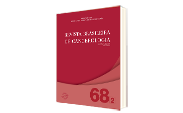Dynamics of Implementation of Humanization in the Pediatric Radiotherapy Service of the National Cancer Institute José Alencar Gomes da Silva, Brazil
DOI:
https://doi.org/10.32635/2176-9745.RBC.2022v68n2.1662Keywords:
humanization of assistance, pediatrics, neoplasms/radiotherapy, childAbstract
Introduction: The treatment of childhood cancer is multidisciplinary and radiotherapy is part of this approach, being, in general, a critical procedure in children. The need to remain unaccompanied and motionless in the treatment apparatus, together with the fear of the nature of this therapy, makes the use of anesthesia common. Humanization measures were introduced in the radiotherapy routine to help children to feel more comfortable and confident with this treatment. Objective: To describe the dynamics of the humanization process. Method: A descriptive study addressing the implementation of humanization measures was developed, between May 2016 and December 2017, in the Radiotherapy Service of the National Cancer Institute José Alencar Gomes da Silva, RJ, Brazil. Result: The customization of the treatment masks, the use of matching costumes, the certificate of courage, the celebrations of festive dates and the improvements in the environment were the main humanization interventions carried out. There was a transformation in coping with the adversities inherent to the treatment, with clear benefits for the environment and the child’s well-being. A trusting relationship was established between the child, his family and the professional team. Greater adherence, reduced absenteeism and an apparent reduction in the use of anesthesia for treatment were found. Conclusion: The actions implemented brought an unambiguous gain in the general well-being of those involved in the humanization process. The necessity of quantitative study on improving the flow of care in the Radiotherapy Service, either by reducing the use of anesthesia for treatment or the daily time spent in the radiotherapy device is highlighted.
Downloads
References
Instituto Nacional de Câncer José Alencar Gomes da Silva. Estimativa 2020: incidência de câncer no Brasil [Internet]. Rio de Janeiro: INCA; 2019 [acesso 2021 mar 15]. Disponível em: https://www.inca.gov.br/sites/ufu.sti.inca.local/files//media/document//estimativa-2020-incidencia-de-cancer-no-brasil.pdf
Novaes PERS. Radioterapia pediátrica: condições para implantação e estratégias para o aprimoramento da assistência. Onco& [Internet]. 2014 set-out [acesso 2021 mar 15]:34-7. Disponível em: https://hugepdf.com/download/radioterapia-pediatrica-condioes-para-implantaao_pdf
Halperin EC, Wazer DE, Perez CA, et al., editors. Principles and practice of radiation oncology. 7th ed. Philadelphia: Wolters Kluwer; 2019. Chapter 1, The discipline of radiation oncology; p. 115-6.
Khurmi N, Patel P, Koushik S, et a. Anesthesia practice in pediatric radiation oncology: mayo clinic Arizona's experience 2014-2016. Paediatric Drugs. 2018;20(1):89-95. doi: https://doi.org/10.1007/s40272-017-0259-8 DOI: https://doi.org/10.1007/s40272-017-0259-8
Ministério da Saúde (BR). Portaria nº 3.390, de 30 de dezembro de 2013. Institui a Política Nacional de Atenção Hospitalar (PNHOSP) no âmbito do Sistema Único de Saúde (SUS), estabelecendo- se as diretrizes para a organização do componente hospitalar da Rede de Atenção à Saúde (RAS). Diário Oficial da União. 2013 dez 31 [acesso 2021 mar 6]; Seção 1:54. Disponível em: http://bvsms.saude.gov.br/bvs/saudelegis/gm/2013/prt3390_30_12_2013.html
Política de Humanização da Assistência à Saúde [Internet]. Rio Grande do Sul: Secretaria de Saúde do Estado do Rio Grande do Sul; c2005. Manual da humanização; [acesso 2020 fev 10]. Disponível em: http://www.humanizasaude.rs.gov.br/site/artigos/manual
Caires S, Esteves CH, Correia S, et al. Palhaços de hospital como estratégia de amenização da experiência de hospitalização infantil. Psico-USF. 2014;19(3):377-86. doi: https://doi.org/10.1590/1413-82712014019003001 DOI: https://doi.org/10.1590/1413-82712014019003001
Silva GH, Piovesan JC. Música e alegria: uma prática humanizada para crianças hospitalizadas. Rev Vivências. 2020;16(30):127-44. doi: https://doi.org/10.31512/vivencias.v16i30.146 DOI: https://doi.org/10.31512/vivencias.v16i30.146
Valladares ACA, Carvalho AMP. A arterapia e o desenvolvimento do comportamento no contexto da hospitalização. Rev Esc Enferm USP. 2006;40(3):350-5. doi: https://doi.org/10.1590/S0080-62342006000300006 DOI: https://doi.org/10.1590/S0080-62342006000300006
Balazy KE, Hiniker SM, Bush K. Impact of audio-visual assisted therapeutic ambience in radiotherapy (AVATAR) on anesthesia use, cost, and time in pediatric patients. Int J Radiat Oncol Biol Phys. 2017;99(Suppl 1):E564-5. doi: https://doi.org/10.1016/j.ijrobp.2017.06.1957 DOI: https://doi.org/10.1016/j.ijrobp.2017.06.1957
Scott MT, Todd KE, Oakley H. Reducing anesthesia and health care cost through utilization of child life specialists in pediatric radiation oncology Int J Radiat Oncol Biol Phys. 2016;96(2):401-5. doi: https://doi.org/10.1016/j.ijrobp.2016.06.001 DOI: https://doi.org/10.1016/j.ijrobp.2016.06.001
Published
How to Cite
Issue
Section
License
Os direitos morais e intelectuais dos artigos pertencem aos respectivos autores, que concedem à RBC o direito de publicação.

This work is licensed under a Creative Commons Attribution 4.0 International License.









